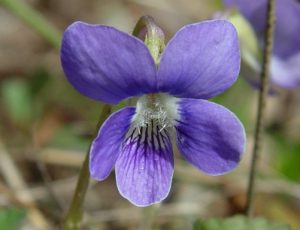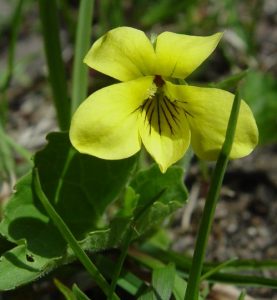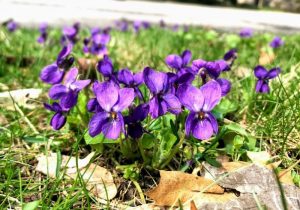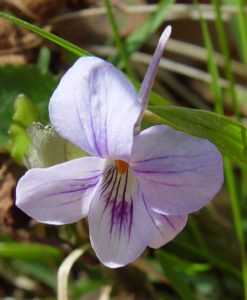A Violet by any Other Name
 When you’re out for a walk and discover a flower that looks like a violet… and smells like a violet… and even tastes like a violet… but isn’t, well, violet-colored… can it still be a violet? Why, of course! We have seventy-seven species of violets growing in North America, with closer to 900 species across the globe. Most people recognize their heart-shaped leaves and their colorful, irregular flowers. Many violets are the familiar bluish-purple color, but they also come in combinations of yellow, white, pink and red.
When you’re out for a walk and discover a flower that looks like a violet… and smells like a violet… and even tastes like a violet… but isn’t, well, violet-colored… can it still be a violet? Why, of course! We have seventy-seven species of violets growing in North America, with closer to 900 species across the globe. Most people recognize their heart-shaped leaves and their colorful, irregular flowers. Many violets are the familiar bluish-purple color, but they also come in combinations of yellow, white, pink and red.
 But why bother with violets? These bright little flowers of the woods and fields are almost as familiar as dandelions. Can they compare to our other spring wildflowers like the exotic-sounding bloodroot, the beautiful and fishily-named trout lily, the ephemeral wood anemone, the delicate, electric-pink-streaked spring beauty or the brilliant large-flowered trillium?
But why bother with violets? These bright little flowers of the woods and fields are almost as familiar as dandelions. Can they compare to our other spring wildflowers like the exotic-sounding bloodroot, the beautiful and fishily-named trout lily, the ephemeral wood anemone, the delicate, electric-pink-streaked spring beauty or the brilliant large-flowered trillium?
Of course! Violets exemplify how exotic the familiar can actually be. We’ve all seen violets before, but how many of us have eaten them? You can nibble them raw, and the leaves are extremely high in vitamin A and C. The Romans kept them on banquet tables to be eaten after a feast, since the salicylic acid in their tissues (related to the acetylsalicylic acid in aspirin) helped with post-party hangovers. And speaking of hangovers, have you heard of a violet’s volatile potential? This little flower might symbolize innocence and modesty, but many of them have seed pods that literally explode at the touch, flinging their seeds several feet from the parent plant.
Or how ’bout this: Did you know that violets flower again, later in the season? These secondary flowers stay low to the earth and never open. Because of this, they’re self-fertilized, producing seeds that lack the genetic variety of cross-pollinated offspring, but that are very likely to thrive in the same environment as the parent plant. Which works out fine, since individual violets can be picky about where they’ll grow.


We’re drawn to the exotic. After being cooped up during a stay-at-home order, how many of us wouldn’t love to see something a little more fresh than our own house and yard? And I hope we all can, sometime soon! But in the meantime, take a walk through your yard or visit a local park and take a look. If you’re lucky, you might come across some common and completely remarkable violets hiding there in the springtime grass.
Written by Justin Smith
